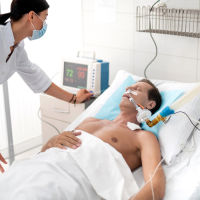Respiratory muscle weakness in critically ill patients is associated with difficulty in weaning from mechanical ventilation. New research also indicates that weaning failure is associated with increased effort of the expiratory muscles and impaired neuromechanical efficiency of the diaphragm, but no difference in tonic activity of the diaphragm.
"However, it is important to note that cardiac dysfunction, cognitive dysfunction, and metabolic disorders are recognised causes for weaning failure as well and may have contributed to weaning failure in the current study," write Jonne Doorduin, PhD, of the Departments of Critical Care Medicine and Neurology, VU University Medical Center (Amsterdam) and co-authors.
Prolonged weaning from mechanical ventilation develops in 6 to 15 percent of mechanically ventilated patients and is associated with increased morbidity and mortality. Previous studies have mainly focused on inspiratory muscle activity during weaning; however, the contributions of expiratory muscles activity are less well understood.
The aim of the current physiologic study was to quantify the expiratory pressure–time product and the expiratory activity of the diaphragm in weaning-success and weaning-failure patients. In addition, the authors studied respiratory muscle activity effort during inspiration.
In the study, 20 adult patients receiving mechanical ventilation (more than 72 hours) performed a spontaneous breathing trial. Tidal volume, transdiaphragmatic pressure, diaphragm electrical activity, and diaphragm neuromechanical efficiency were calculated on a breath-by-breath basis. Inspiratory (and expiratory) muscle efforts were calculated as the inspiratory oesophageal (and expiratory gastric) pressure–time products, respectively.
Nine patients failed weaning. The contribution of the expiratory muscles to total respiratory muscle effort increased in the “failure” group from 13 ± 9% at onset to 24 ± 10% at the end of the breathing trial (P = 0.047); there was no increase in the “success” group. Further, diaphragm electrical activity, expressed as the percentage of inspiratory peak, was low at end expiration (failure, 3 ± 2%; success, 4 ± 6%) and equal between groups during the entire expiratory phase (P = 0.407). Diaphragm neuromechanical efficiency was lower in the failure versus success groups (0.38 ± 0.16 vs. 0.71 ± 0.36 cm H2O/μV; P = 0.054).
"In the weaning-failure group, the contribution of the expiratory muscles to total respiratory muscle effort progressively increased during the spontaneous breathing trial, whereas it remained stable in successfully extubated patients," the authors note. "Whether the increase in expiratory muscle effort resulted from activation of the abdominal muscles, expiratory rib cage muscles, or a combination of the two is unknown; the relative contribution of each muscle group during expiration cannot be derived from the expiratory rise in gastric pressure."
Moreover, reduced neuromechanical efficiency in the failure group may largely be explained by structural modifications, such as diaphragm atrophy, but we cannot completely rule out impaired respiratory mechanics, the authors add.
Source: Anesthesiology
Image Credit: Rcp.basheer
References:
Doorduin J et al. (2018) Respiratory Muscle Effort during Expiration in Successful and Failed Weaning from Mechanical Ventilation. Anesthesiology Published on 15 May 2018. doi:10.1097/ALN.0000000000002256
Latest Articles
mechanical ventilation, weaning failure, expiratory muscle effort, Respiratory muscle weakness
Respiratory muscle weakness in critically ill patients is associated with difficulty in weaning from mechanical ventilation. New research also indicates that weaning failure is associated with increased effort of the expiratory muscles and impaired neurom



























